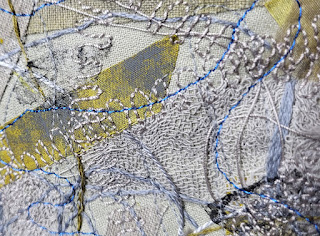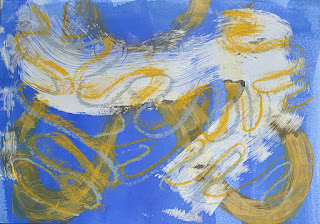 |
| Test weaving |
This is a little test weaving where I tried to reproduce a richly textured surface reflecting the feel of an old and weathered industrial site. I used hatching to blend some colours but also did some needle punching and hand embroidery in some areas to introduce more textures.
In the following samples I used paper as I didn't want to waste my precious fabric samples.In order to reproduce the colours and textures more accurately, I took a picture of the fabric samples which I printed out on a A4 sheet of paper.
 |
| Sample 1 |

 |
| Sample 2 |
Sample 3
I decided that my initial shape didn't have enough potential and flexibility to develop further so I did some changes to it . The final shape allows more room for intertwining
 |
Sample 4
For more contrast the shapes were put onto a plain coloured background |
 |
| Sample 5 |
 |
Sample 6
|
No I have to make up my mind when it comes to the sewing and which sample to choose.
Before cutting out the shapes outlined them first with cable stitch. This allows the fabric not to fall apart.
I opted for a blue colour for the shape and for a beige colour for the curved lines with an ocre upper thread.
The shapes were traced on the back before being stitched and cut out.
The shape was mirrored .
Before the actual sewing I played around with them as I had an idea in mind and wanted to see what it would look like.
Some ideas before the sewing: shapes put onto the neutral background. They are not fixed yet but I like the way they ondulate, it looks more interesting than if they laid flat.
-------------------------------
I was very much attracted by the shape of the blast furnace which is the landmark of the Belval industrial site. It looks very majestic a bit like a fortress.
I know it is a very simple (vase) shape but I like the idea of having this kind of "canvas" .They are just some basic ideas which are difficult to get out of my head once they have settled in there:(
Hereafter are some ideas where I played loosely with the shapes, pinning them onto some felted fabric wrapped around a piece of EVA foam.
The size of the pipe is not wright, it needs to be bigger.
Here the curved stripe was wrapped around the tube with the shapes intertwined, This is actually the sample I prefer as it relates to the idea of the conveyor belt where the finished items are transported.
In the following example the shapes are put in an unorganized way onto the tube

























































